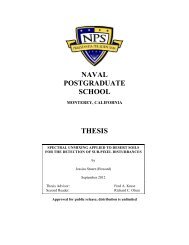October 2000 Newsletter - Naval Postgraduate School
October 2000 Newsletter - Naval Postgraduate School
October 2000 Newsletter - Naval Postgraduate School
Create successful ePaper yourself
Turn your PDF publications into a flip-book with our unique Google optimized e-Paper software.
FEATURED PROJECT<br />
JP-10/AEROSOL FOR PULSE DETONATION APPLICATIONS, continued from page 7<br />
Due to the increased difficulty of detonating a fuel/air<br />
mixture, a small (pilot) combustor which operated on JP-10<br />
and oxygen was used to generate a very strong detonation<br />
wave and provide the initiating shock wave for the JP-10/air<br />
mixture. The geometry was previously determined by LT<br />
Dave Forster, USN, to provide the most rapid and reliable<br />
generation of a detonation wave in a JP-10/oxygen aerosol.<br />
The strong shock wave generated by this pilot combustor<br />
results in the direct transition of the detonation wave into the<br />
fuel/air mixture as long as the mixture is within a known<br />
detonability limit.<br />
The atomizers used in this work produced sprays with low<br />
Sauter Mean Diameters (SMD), typically 7mm to 10mm over<br />
a wide range of flow rates, thereby allowing the spray SMD to<br />
be approximately constant through a wide range of fuel/air<br />
ratios. SMD values of the aerosol exiting the inlet arms were<br />
measured for conditions ranging from a temperature of 285K<br />
to 500K and air flow rates of 0.07 kg/s to 0.30 kg/s. By<br />
combining the measured particle size and concentration and<br />
knowing the initial amount of fuel sprayed, the amount of<br />
fuel vaporized at the point of injection into the main combustor<br />
was estimated. The results for an air flow rate of 0.20 kg/s<br />
and overall equivalence ratio of 1.5 for the JP-10/air mixture<br />
are shown below in Figure 4 for varying engine inlet temperatures.<br />
Detonations were only observed for inlet temperature<br />
above approximately 345K. The corresponding aerosols<br />
detonated therefore had SMD values below approximately 3<br />
microns and an estimated fuel vapor above 70%. Test runs<br />
which demonstrated a higher success rate at producing<br />
detonations were for higher inlet air temperatures and<br />
subsequently smaller droplets and fully vaporized fuel. A<br />
sample trace for one cycle of a JP-10/air detonation is shown<br />
in Figure 5 for an engine inlet temperature of 425K. The fuel<br />
was completely vaporized before initiation for this case. The<br />
pressure-time traces reveal the extremely high detonation<br />
wave velocities observed and the result head-end pressure<br />
which produces the thrust for these systems.<br />
The successful detonations observed possessed detonation<br />
wave speeds generally within 2% of the expected Chapman-<br />
Jouget values. This result appears to indicate that although a<br />
portion of the fuel may have been in a liquid state, enough<br />
fuel vapor was present to initiate a reaction and provide rapid<br />
heating, vaporization, and reaction rates behind the shock<br />
wave to result in near Chapman-Jouget velocities.<br />
The JP10-fueled pulse detonation engine has been operated<br />
at frequencies up to 5Hz and is in the process of being<br />
retrofitted with new fuel injectors to investigate operation at<br />
up to 100Hz. Performance parameters will be measured as a<br />
function of cycle frequency, simulated flight velocity, partial<br />
--continued on page 42<br />
Figure 4 (left). Sauter Mean Diameter and Percent Fuel<br />
Vaporization as Function of Temperature.<br />
Figure 5 (above). Pressure-Time Trace for JP10/Air Detonation.<br />
NPS Research page 41<br />
<strong>October</strong> <strong>2000</strong>
















